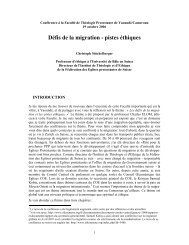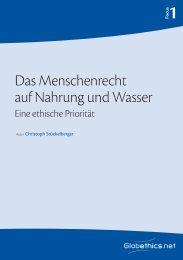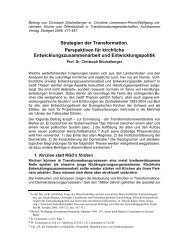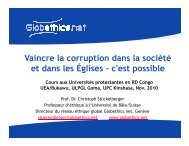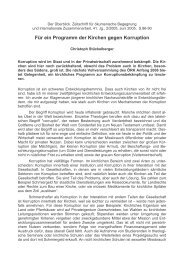BREAK THE CHAINS OF OPPRESION AND THE YOKE OF ...
BREAK THE CHAINS OF OPPRESION AND THE YOKE OF ...
BREAK THE CHAINS OF OPPRESION AND THE YOKE OF ...
Create successful ePaper yourself
Turn your PDF publications into a flip-book with our unique Google optimized e-Paper software.
Litur gy<br />
We therefore have to be acutely aware that all our liturgical interaction carries<br />
meaning which will be measured against our interaction as believers outside the<br />
liturgy also.<br />
The smallest of gestures will tell not only others, but ourselves about the measure<br />
of integrity we seek to live.<br />
What does it say when the surplus bread of the communion celebration is simply<br />
consigned to the bin? What does it say when the celebrant does not raise the<br />
chalice high enough for all to see? Are these liturgical minutiae? Insignificant? Or<br />
filled with meaning of the intended or unintended kind?<br />
The liturgy of Communion tells us who we are, whose we are and how we are to<br />
live. The liturgy of Communion and the issue of justice are linked inextricably<br />
for the very simple reason that we confess Jesus as Lord. But it is God’s justice<br />
that we are confronted with and it has initially more to say about us, than we<br />
have to say about others.<br />
At the heart of God’s justice lies the recognition and confession of our injustice:<br />
our injustice, not that of others. ‘The woman you gave me….’ – pointing the<br />
finger at others will not do.<br />
It is therefore significant to note that in relation to Holy Communion and the issue<br />
of justice, it is first and foremost God’s justice we are concerned with and<br />
then our injustice. Our subsequent concern for justice is an outflowing of that<br />
primary recognition that justice is not ours, but it is God’s and is given to us as a<br />
gift and a gracious mercy which is not to be appropriated for our private salvation<br />
but to be shared for that of the whole of creation.<br />
� � � � �<br />
At the centre of the liturgy we therefore confess Jesus as Lord and God as the author<br />
of justice, divine justice. And we confess ourselves as not just, but trusting<br />
ourselves to be justified through Christ.<br />
In the liturgical history of the church this has been supremely expressed in the<br />
agnus dei in preparation for the receiving and sharing of Holy Communion.<br />
The interaction of the short phrases between celebrant and congregation expresses<br />
that interrelationship between God’s merciful justice and our injustice<br />
and it is at this point that consideration shall be given to a liturgical development<br />
which has taken place in the Reformed tradition within Scotland, but may have<br />
found similar expressions in other branches of the Reformed family of churches.<br />
Originally intended as a liturgical interaction between the celebrant and the congregation,<br />
such responses as indicated in the agnus dei were by gradual process<br />
appropriated for the use of the celebrant alone – possibly out of a misguided fear<br />
of being perceived to be too Roman-catholic or Episcopalian - and thereby rendering<br />
the role of the congregation as that of passive recipient rather than active<br />
participant in the liturgy and drama of salvation of not only Holy Communion,<br />
������������������������������������������������<br />
� � � � � �����������������������<br />
�<br />
104<br />
– <strong>THE</strong> LITURGY <strong>OF</strong> HOLY COMMUNION –



